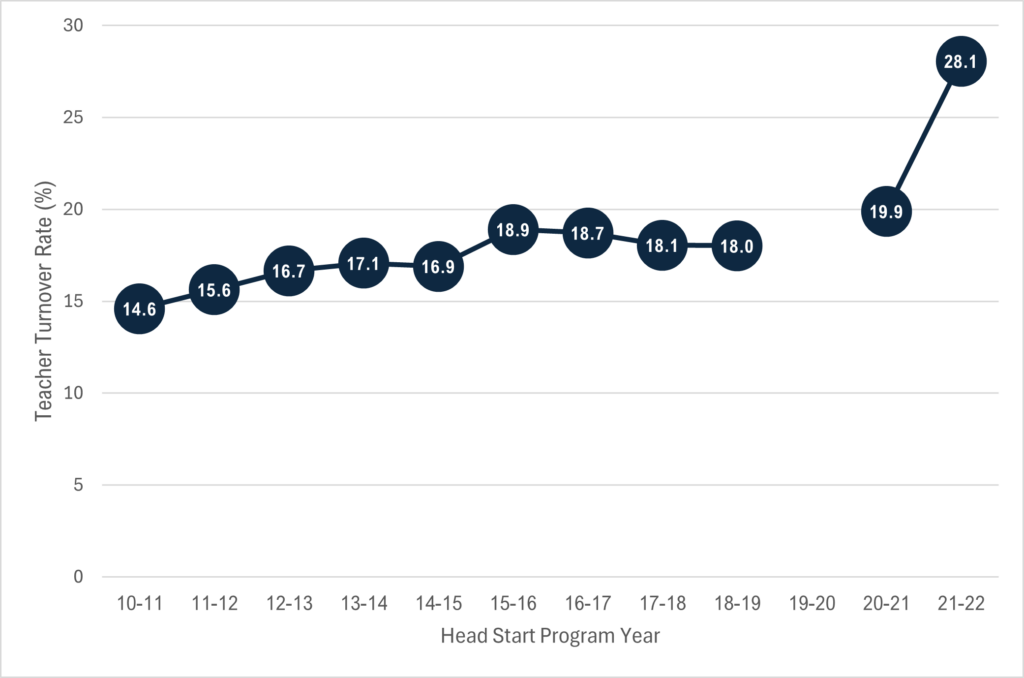Head Start, the federal early childhood education program that serves more than 500,000 children, witnessed an unprecedented spike in teacher turnover during COVID-19. Here, we explain the main findings of RFA’s recent study and discuss factors that may be contributing to this surge. The Administration of Children and Families (ACF) Office of Planning, Research, and Evaluation funded the study.
Head Start plays a pivotal role in providing comprehensive early childhood education and development services to children and families living on low incomes. Established in 1965, the program aims to ensure that all children, regardless of their economic background, have access to the resources necessary for a healthy and successful start in life. Head Start’s success hinges on a stable workforce. A consistent teaching staff is crucial for building strong relationships with children and families, fostering early development, and implementing high-quality curriculum. High turnover can lead to disruptions in curriculum implementation and program quality, ultimately impacting children’s outcomes. Understanding why teachers are leaving Head Start is essential for improving retention and ensuring continued program success.
A Surge in Staff Turnover During COVID-19
RFA’s analyses of Head Start administrative data found a statistically significant uptick in teacher turnover in both years following the COVID-19 pandemic for which we have data. The turnover rate increased to 20% in the 2020-21 program year and, in a particularly sharp increase, to 28% in 2021-22. Both years were the highest on record, and 2021-22 represents the first year that Head Start teacher turnover exceeded a quarter of all Head Start teachers.
Head Start Teacher Turnover, 2010-11 to 2021-22

Potential Factors Contributing to Turnover
- Trends in the Education Workforce: The spike in Head Start staff turnover mirrors trends observed in K-12 education. In the 2019-2020 and 2020-21 school years, the first two school years affected by the pandemic, teacher retention in K-12 remained relatively stable. However, one analysis of 15 states found that K-12 teacher turnover began to increase across the country in the 2021-22 school year. The commonalities between Head Start staff turnover and K-12 teacher turnover suggest broader issues affecting the education workforce as a whole.
- Compensation: Compensation was the biggest single reason (27%) given for why teachers exit Head Start, followed by retirement or relocation (11%), and involuntary separation (11%). This is in line with previous research conducted by RFA that found an urgent need for increased pay for early childhood educators.
- COVID-19: The lingering effects of the COVID-19 pandemic also appear to have taken a toll on educators. RFA’s additional analysis of open-ended responses in the Head Start administrative data found that many Head Start operators wrote in COVID-19 as a prominent reason for staff exits during both 2020-21 and 2021-22. The constant adaptation to remote learning, health concerns, and emotional strain may have led to burnout and fatigue.
The spike in staff turnover within Head Start in the 2021-22 program year is concerning and appears to mirror trends in K-12 teacher turnover. These high turnover rates create significant challenges for Head Start operators and can be harmful to children and their families. Ongoing monitoring of staff and teacher turnover, along with reforms to improve retention, will be needed to ensure program stability and maintain supportive environments for Head Start children.
